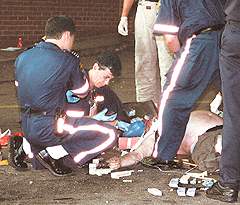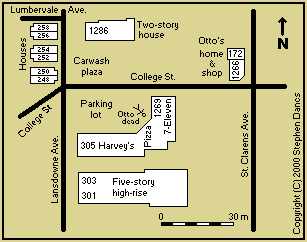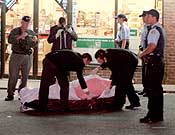

Vivian describes herself as a "middle-aged, middle-class, law-abiding citizen." On Saturday, March 23, she decided to go with some friends to the second day of protests held in downtown Toronto to coincide with the provincial Tory leadership convention.
She had been to many rallies against the provincial government. "But this time was different," she writes in the account of the day's events she composed in response to questions from eye. "I have never seen the police attack citizens before, and it is deeply disturbing."
That afternoon, protesters gathered at Allan Gardens. They say police declared over a megaphone that the demonstration was an illegal assembly. Protesters then tried to leave the park -- some individually, some in a march -- and that's when things got bad.
"The march had just started from Allan Gardens," writes Vivian, "when several cops plunged into the marchers and jumped on a teenage girl, knocking her to the ground face-first. Then two of them held her down while a third one beat her on the legs. They had the girl facedown in the mud, two big cops were on her arms and the third cop -- a woman! -- was whacking away at the girl's legs.
"Other cops came rushing over, and I thought they might be coming to cool the situation down, but instead they formed a circle and the beating continued within the circle. It was insane. If they wanted to arrest this girl for some reason, why didn't they just arrest her by grabbing her arms and handcuffing her?
"She wasn't even kicking or thrashing about, she was just lying there completely still while they beat her. I'll never lose the image that is burned in my brain of the one time she lifted her head and looked around, blood pouring down her face, and her mouth moving with no sound coming out."
Officers who formed the circle started to strike out at bystanders, Vivian claims, and so march organizers told the observers to move on. "My friend and I... sort of stumbled away in shock," she writes, "not knowing whether to cry, scream or throw up."
Vivian's friend Alan Carlisle was also at the protest, along with his wife, Linda. His last contact with the police, he says, occurred in 1989, when he was commended by Toronto police for his help in the case of missing teenager Benji Hayward.
He too was surprised at what he saw that afternoon at Allan Gardens: he says he saw yellow-clad bicycle officers taking part in the violence. "The bicycle cop is [supposed to be] your friend," he says, "[but they were] pounding people." Carlisle says his wife Linda was hit with a fist in the melee.
"Nothing in my 55 years taught me that the police have the right to beat people," he says. "That's not their job so far as I've understood. I couldn't imagine what these people did to deserve anything like this."
Since that weekend in late March, citizens have continued to raise concerns about police conduct. Those present at protests on both the Friday and Saturday claim that police heavy-handedness in Toronto was taken to a whole new level. Hours of footage were shot of the events.
While those events were held downtown, they were not close to the actual Tory convention, which was held at the Metro Toronto Convention Centre on Front Street West.
Eighty arrests were made over the weekend; in addition to accounts of police beatings, protesters say tear gas and strip searches were used, and even that some officers wore balaclavas and had their identity badges obscured by equipment.
Sgt. Jim Muscat, a Toronto Police Service spokesman, says the demonstrations on both the Friday and Saturday went "pretty much as we expected."
"We live in a democracy, and people are welcome to hold demonstrations as long as they're peaceful and as long as there's no criminal activity," says Staff Sgt. Doug Hutton of 52 Division. "We're there to assist them in doing that."
He says the police presence that weekend was supplemented by officers from other regions, including Ontario Provincial Police and officers from Barrie. But Hutton says he has no idea how many officers were there.
Asked whether he's heard concerns about police behaviour, particularly on the Friday night, Hutton replied: "I haven't heard any reports of that." He would not refer eye to any officers who were present at the protests.
Over the weekend there were incidents "where we were concerned with the level of criminal activity we were seeing," says Hutton.
On the night of Friday March 22, the events planned downtown included a march and a squat in the empty Mission Press building at 53 Dundas St. East -- a "symbolic" protest in that it was the sort of building that might be used for affordable housing, because it has running water, electricity and heat.
Sharaz, a member of the Ontario Common Front who doesn't want his last name used, took part in that squat. "This was really a lightweight action we had planned," he explains. He says the squat and protest was attended by an unprecedented number of police officers with a very high level of weaponry.
Hutton says he understands that tear gas was used on the Friday night. Protesters say a device was thrown through the window of the building -- breaking the windows and causing the evening's only significant property damage -- before releasing a pepper spray-like gas on impact.
"I even saw cops with orange capes... I think they were kind of like supercops," says Sharaz, also citing Darth Vader-style helmets, black balaclavas, guns with laser sights and Tasers, which are non-lethal weapons that cause electric shocks.
Footage shows protesters walking out of the building with their hands in the air. It also shows red dots, like those projected by laser sights, trained on the protesters' heads and hearts in "kill shots." After police enter the building, one officer is visible through an upstairs window, beating a banner with his baton.
Nine hours after his arrest that night, Sharaz says he was lined up in a police station garage with a group of about 15 male demonstrators, hands tied tightly behind his back with plastic twist-ties. At this point, according to Sharaz, one officer said to him, "Oh, just like Germany. Get ready for the showers, boys."
Male and female arrestees say they were strip-searched that night. Hutton, though, says strip searches are no longer performed by the police -- only "complete searches," in which some or all articles of clothing may be removed.
For complete searches to be legal, the police must have reasonable grounds to believe that weapons, drugs or evidence will be found on the person. Hutton will neither confirm nor deny that complete searches were conducted in these cases.
Hutton also says that "one of the issues that night was that some of the people involved broke into a building which was private property."
The next day, Saturday, March 23, protesters gathered at Allan Gardens. After police declared the rally illegal, some demonstrators say they tried to leave the park, but were surrounded by police and weren't allowed to go. (Hutton says it "wouldn't be true" that people weren't allowed to leave.) Some protesters were arrested for walking onto the road.
Video footage shot at the scene shows officers beating unarmed demonstrators with fists and batons as observers shout at the police and chant "Fuck you, fifty-two [Division]."
Vivian continues about watching the girl being beaten: "As I looked back over my shoulder," she writes, "I was relieved to see an ambulance pulling up. I thought surely the paramedics would put an end to it before the girl's legs were broken. I would guess that they are generally not in favour of broken legs. I just about fainted with shock when the ambulance doors burst open and about a dozen cops with tear gas guns came leaping out.
"This whole incident was well recorded -- I saw many cameras and video cameras -- but we didn't see anything about this incident on the news.
"I've had second and third and fourth thoughts about writing this, because I am afraid by writing it, my name might get put down on some secret police list, and the next time I need the police to perform their proper functions of serving and protecting I might be waiting a long time for a response."
Sarah Vance, of the Ontario Coalition Against Poverty, says she believes the idea behind heavy-handed police response to demonstrations is to increase the risks for people such as Carlisle and Vivian -- who can choose to avoid coming into contact with police -- of taking part in demonstrations.
"In many ways the Toronto police force is out of control right now," says Anna Willats, a member of the newly formed Toronto Police Accountability Coalition.
The coalition -- which includes eye columnist John Sewell -- will present a proposal this weekend for guidelines regarding police conduct at demonstrations.
"White middle-class conservative-acting people may never encounter a cop," she says. "Many people in Toronto have no idea. We have to make people who don't come into contact with the police aware of the reality for most people."
Carlisle says he called Toronto councillor Bas Balkissoon, then a member of the police services board, to complain about what he saw, but was unable to speak to the councillor.
Soon after, he learned that Balkissoon had quit the board in frustration at his purely "ceremonial role." The Scarborough councillor said board chair Norm Gardner and Police Chief Julian Fantino would not allow him or other members to ask questions or affect policy.
"Why do cops behave the way they can?" Willats asks. "Because they get away with it."
-----------------------------------------------------------------------------------------------



Ottó Attila Vass
Jan. 17, 1945 -- Aug. 9, 2000
Victim of Toronto Police brutality.
Eyewitness Amir Hameed, 23, who watched the incident with his roomate Asim Abbasi, 30, from their front porch at 250 Lansdowne Ave., roughly 40 metres away, said: "They [the police] were beating him worse than an animal. He wasn't fighting back at all." Another witness, a woman who was in the 7-Eleven parking lot, said that two officers kicked and elbowed Otto and then another squad car arrived, and "one officer ran accross the parking lot and kicked him in the face." Another woman, who used binoculars and watched the altercation from her fifth-floor apartment, said she saw Otto on the ground, on his stomach, hollering in pain with his face "all bloodied."
This was NOT an accident, it was murder and THE POLICE are responsible. We cannot forget about Otto and his tragic death. This can happen to anyone. This cannot continue. We cannot bring back Otto, but we can bring justice so that his death will not be in vain. If you or anyone has any information regarding his death, please contact the Special Investigations Unit, St. Elizabeth Church of Hungary, the Hungarian community. Please help Otto, his family & friends.